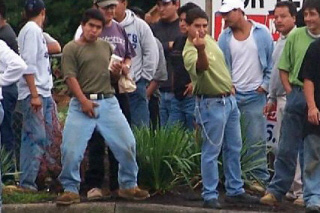December 28, 2007, - 11:21 am
Scientist: Illegal Aliens @ Border Ruined My Work
By Debbie Schlussel
You know the illegal alien and lax borders problem is bad when even a member of the liberal science intelligentsia doth protest.
That’s the case with biologist Karen Krebbs, who studies bats, er . . . used to study bats at the Organ Pipe Cactus National Monument on the Arizona-Mexico border. You see, she got tired of avoiding drug smugglers all night long.
Of course, leave it to the MSM–and the liberal scientists–to spin this as a “result” of “increased” border enforcement–the smugglers have to sneak through the park because of increased enforcement elsewhere on the border, they claim. My question is–if a scientist can find these dozens of drug smugglers on a nightly basis, why can’t U.S. Border Patrol? And, hey, I learned something new–there is a patron saint of . . . drug smugglers?:

“I use night-vision goggles and you could see them very clearly,” Krebbs said of the caravans of men with guns and huge backpacks full of drugs, trudging through the desert. After taking refuge in bushes or behind rocks on 10 or so occasions, Krebbs abandoned her research. “I’m just not willing to risk my neck anymore,” she said.
Along the U.S.-Mexican border, scientists like Krebbs say their work is under growing threat from drug traffickers and other criminals who have been pushed into remote areas by tighter U.S. border security.
Richard Felger, a botanist, said he stays away from remote mountains in the Mexican border state of Sonora after being robbed and threatened on research trips.
“I got kind of allergic to pistols being held to my forehead,” Felger said.
There are no statistics on how many scientists have been attacked or threatened, said Mark Frankel, director of the scientific freedom program at the American Association for the Advancement of Science. But among researchers, stories of theft and armed robbery are common.
“In the last year it has gotten much worse,” said Jack Childs, who studies endangered jaguars in eastern Arizona with infrared cameras. He loses one or two of the cameras every month to smugglers.
Childs has tried leaving notes and pictures of saints — even Jesus Malverde, the unofficial, folklore saint of drug traffickers — to try to persuade smugglers to spare his cameras, but to no avail. Each camera costs $450.
Scientists long have shared the border area with marijuana growers and immigrants trying to enter the USA illegally. But tension is rising because of a crackdown on smugglers by the Mexican military, new border fences, patrols by unmanned planes, a buildup of U.S. Border Patrol agents and a turf war between cartels.
“It’s a kind of arms race, and biologists are stuck in the middle,” said Jim Malusa, who specializes in mapping desert vegetation. “There has been a chilling effect on researchers.”
Michael Wilson, a botanist and director of research at the Drylands Institute in Tucson, said he avoids some parts of Mexico’s Sonora state after seeing opium poppies, which are not native to Mexico, and mules carrying loads of marijuana down from the mountains. Opium resin is used to make heroin.
Wilson said he has noticed an increase of marijuana cultivation in recent years, and more people watching over the fields. Some of his colleagues now carry guns, he said.
“There are a lot of researchers who have ducked out of doing research in Mexico,” Wilson said.
Scientists working at sea have also had their work disrupted.
Jeffrey Seminoff, an ecologist with the U.S. National Marine Fisheries Service, said smugglers have robbed boat fuel from his researchers at gunpoint in the Gulf of California, leaving them just enough gas to get back to shore.
In May, Seminoff stumbled across a camouflaged drug boat in a cave near San Carlos, Sonora, while setting nets for sea turtles.
“They definitely had guns, so we just kind of backed off. So one of our primary turtle capturing sites we had to abandon for the day,” he said. . . .
The resulting paralysis is creating gaps in scientific knowledge, researchers complain. . . .
“This sort of stuff definitely puts holes in our sampling,” Hendrickson said. “The drug stuff is definitely affecting research.”
Yes, this problem affects everything. Maybe one day a President will actually care about stopping it. But, then, it will be too late.
It’s already too late.
Tags: American Association for the Advancement of Science, Arizona, Arizona-Mexico border, biologist, botanist, botanist and director, botanist and director of research, California, Debbie Schlussel, director of research, director of the scientific freedom program, Drylands Institute, ecologist, Gulf of California, Jack Childs, Jeffrey Seminoff, Jesus Malverde, Jim Malusa, Karen Krebbs, Mark Frankel, Mexican military, Mexico, Michael Wilson, Organ Pipe Cactus National Monument, paralysis, President, Richard Felger, scientist, Sonora, U.S. National Marine Fisheries Service, U.S.-Mexican border, United States, USD


The problem with this Debbie, is that the hypocrisy of academia becomes overtly evident in that it takes something like “I can’t collect my bats for study on tuesday” to make them see it as an issue rather than something like the crime rate is up, welfare costs are exploding, drug running is rampant, hospitals in SoCal are closing their emergency services, etc.. etc.. etc… the list is endless….
I’ve lived in that looney toon world of academia for a long time and it never fails to amaze me at how much cognizant dissonance and ludicrous logic gets applied in that realm.
Mistress_Dee on December 28, 2007 at 2:17 pm